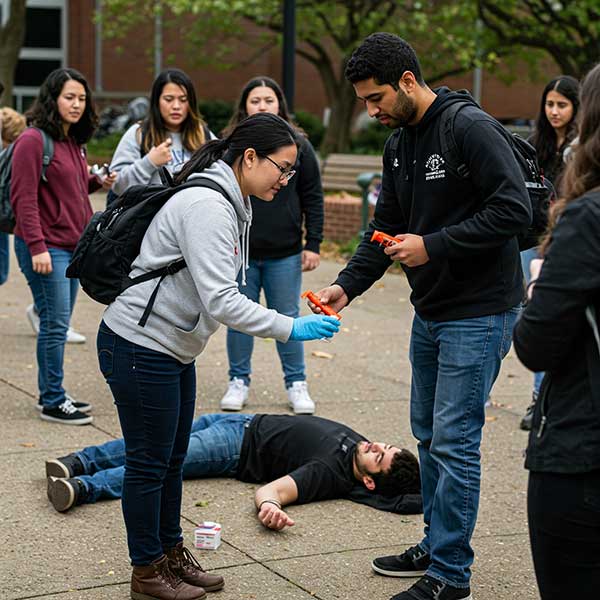
In a groundbreaking move to combat the opioid crisis, Massachusetts University has become the first academic institution to pilot NALCAM (which stands for Naloxone Carriage Advancement and Motivation), an innovative technology designed to enhance naloxone carriage and overdose prevention. NALCAM represents a significant leap forward in public health innovation, offering a streamlined and efficient way to ensure that life-saving naloxone is readily available in emergency situations. As opioid-related deaths continue to rise across the United States, this pilot program could serve as a model for other universities and communities seeking to reduce fatalities and improve access to critical overdose-reversal medication.
The opioid epidemic remains one of the most pressing public health challenges in the nation. According to the Centers for Disease Control and Prevention (CDC), over 100,000 drug overdose deaths occurred in the U.S. in a single year, with synthetic opioids like fentanyl driving much of the increase. Naloxone, a medication that can rapidly reverse opioid overdoses, has been a cornerstone of harm reduction efforts. However, barriers such as stigma, accessibility, and lack of awareness have limited its widespread use. NALCAM seeks to address these challenges by integrating advanced technology with user-friendly design, making naloxone more accessible than ever before.
Developed by a team of public health experts, engineers, and medical professionals, NALCAM functions as a compact, portable device that carries and dispenses naloxone with minimal user effort. The technology includes features such as real-time overdose detection, GPS tracking for emergency response coordination, and a step-by-step guidance system to assist bystanders in administering the medication. Unlike traditional naloxone kits, which require manual assembly and administration, NALCAM automates much of the process, reducing the risk of delays or errors during an overdose emergency.
Massachusetts University’s decision to pilot NALCAM aligns with its commitment to public health innovation and student safety. The university, located in a state that has been heavily impacted by the opioid crisis, has long been a leader in harm reduction initiatives. By implementing NALCAM on campus, the institution aims to create a safer environment for students, faculty, and visitors while gathering valuable data on the technology’s effectiveness. The pilot program will involve placing NALCAM devices in high-traffic areas such as dormitories, libraries, and student centers, as well as training campus security and health services personnel in their use.
One of the most promising aspects of NALCAM is its potential to empower bystanders to act quickly in overdose situations. Many overdose deaths occur because witnesses are unsure how to respond or are afraid of legal repercussions. NALCAM’s intuitive interface and clear instructions help alleviate these concerns, providing users with the confidence to intervene. Additionally, the device’s ability to alert emergency services automatically ensures that professional medical help is on the way, even if the bystander is unable to call for assistance themselves.
The pilot program at Massachusetts University will also include an educational component aimed at raising awareness about opioid overdose prevention. Students and staff will have the opportunity to attend workshops and training sessions on recognizing the signs of an overdose, administering naloxone, and understanding the role of harm reduction in public health. By combining technology with education, the university hopes to foster a culture of preparedness and compassion, reducing the stigma often associated with substance use disorders.
If successful, the NALCAM pilot could have far-reaching implications beyond the university setting. Communities across the country could adopt similar programs, deploying the technology in public spaces such as parks, transportation hubs, and entertainment venues. Public health officials have long emphasized the importance of making naloxone as ubiquitous as automated external defibrillators (AEDs), and NALCAM brings that vision closer to reality. The data collected during the Massachusetts University pilot will be crucial in refining the technology and making the case for broader implementation.
Critics of naloxone distribution programs have argued that increasing access to the medication could enable risky behavior among opioid users. However, research has consistently shown that naloxone does not encourage substance use but instead saves lives, providing individuals with the opportunity to seek treatment and recovery. NALCAM’s design further mitigates these concerns by focusing on ease of use and rapid response, ensuring that the primary goal remains harm reduction rather than enabling addiction.
The development and deployment of NALCAM also highlight the importance of interdisciplinary collaboration in tackling complex public health issues. Engineers, medical professionals, and policymakers worked together to create a solution that is both technologically advanced and socially impactful. Massachusetts University’s role as the first testing ground for this innovation underscores the vital contributions that academic institutions can make in addressing societal challenges.
As the pilot program gets underway, stakeholders will be closely monitoring its outcomes, including the number of overdoses reversed, response times, and user feedback. Early indications suggest that NALCAM has the potential to revolutionize overdose prevention, offering a scalable and effective tool in the fight against the opioid epidemic. If proven successful, this technology could mark a turning point in public health strategy, demonstrating that innovation and compassion can go hand in hand in saving lives.
Massachusetts University’s pioneering efforts with NALCAM serve as a beacon of hope in an ongoing crisis. By embracing cutting-edge technology and fostering a community-centered approach to harm reduction, the institution is setting a powerful example for others to follow. As the nation grapples with the devastating effects of opioid addiction, initiatives like this remind us that progress is possible—one life-saving innovation at a time.